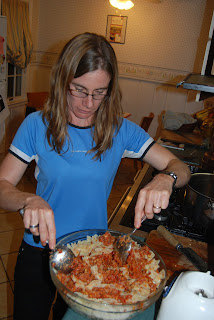I've tackled the first of several gelato recipes in the book finally. This weekend we tried out the black walnut gelato. Here's the Cliff Notes version: blend to a paste the nuts, add to scalded milk, run through cheesecloth, cool, add sugar, maple syrup and yolks, heat, cool, freeze.
I tried to follow the directions to the letter but looking back I did omit the part where I was supposed to rub the black walnut skins off. And, I bet that was a crucial step.
The ice cream set up nicely and was very strongly flavored. It had a bitterness that I think was from the leaving the skins on.
It's the kind of ice cream that one doesn't want a cup or two of, but a nice scoop with a cookie on the side. Bernadette recommended serving this ice cream with spicy lace wafers and I wanted to, but ran out of time to make them.
I like making the gelato. It's a nice recipe to make if you have several hours before you are going to serve it and can let the ingredients heat and cool like they are supposed to. It's not that it's too time consuming. There just has to be enough time to let it cool a few times.
I remember once eating four black walnut ice cream cones at the Gasconade County Fair. At 25 cents per cone it was just too cheap and yummy to pass up. This gelato was different from that and all other black walnut ice cream I've had in that there were no pieces of nut, the nuts had all been strained out. The gelato is to black walnut ice cream like jelly is to jam, I guess.
Lessons learned from this recipe, besides take the nut skins off--call it gelato or whatever, black walnuts in ice cream rocks!
I tried to follow the directions to the letter but looking back I did omit the part where I was supposed to rub the black walnut skins off. And, I bet that was a crucial step.
The ice cream set up nicely and was very strongly flavored. It had a bitterness that I think was from the leaving the skins on.
It's the kind of ice cream that one doesn't want a cup or two of, but a nice scoop with a cookie on the side. Bernadette recommended serving this ice cream with spicy lace wafers and I wanted to, but ran out of time to make them.
I like making the gelato. It's a nice recipe to make if you have several hours before you are going to serve it and can let the ingredients heat and cool like they are supposed to. It's not that it's too time consuming. There just has to be enough time to let it cool a few times.
I remember once eating four black walnut ice cream cones at the Gasconade County Fair. At 25 cents per cone it was just too cheap and yummy to pass up. This gelato was different from that and all other black walnut ice cream I've had in that there were no pieces of nut, the nuts had all been strained out. The gelato is to black walnut ice cream like jelly is to jam, I guess.
Lessons learned from this recipe, besides take the nut skins off--call it gelato or whatever, black walnuts in ice cream rocks!
 |
| Carlos and Tracey enjoying some black walnut gelato. |























